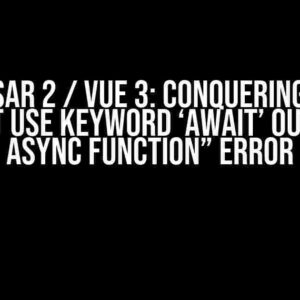Are you tired of dealing with the frustrating “Expected a value of type List<ClassroomRoutineModel>, but got one of type List <dynamic>” error when trying to migrate to null-safety in Dart? You’re not alone! In this comprehensive guide, we’ll take you by the hand and walk you through the steps to resolve this pesky issue once and for all.
What is Null-Safety?
Before we dive into the solution, let’s quickly cover what null-safety is and why it’s essential in Dart.
Null-safety is a feature in Dart that ensures your code is free from null pointer exceptions. It does this by introducing a concept called “sound null safety,” which guarantees that a variable can never hold a null value unless you explicitly declare it as nullable.
In Dart, a nullable type is denoted by a question mark (?) after the type name, like this: `String? myString`. This tells the compiler that `myString` can hold either a string value or null.
The Problem: “Expected a value of type List<ClassroomRoutineModel>, but got one of type List <dynamic>”
So, what’s the issue here? When you try to assign a list of dynamic objects to a variable declared as `List
The error message is telling you that it expected a list of `ClassroomRoutineModel` objects, but instead, it got a list of dynamic objects. This is because the `dynamic` type is the default type in Dart when no type is specified.
The Solution: Understanding Type Casting
To resolve this issue, we need to understand type casting in Dart. Type casting is the process of converting one data type to another. In our case, we need to cast the dynamic list to a list of `ClassroomRoutineModel` objects.
There are two types of casting in Dart: implicit and explicit casting.
Implicit Casting
Implicit casting occurs when Dart infers the type of a variable based on the assigned value. For example:
var myList = [ClassroomRoutineModel(), ClassroomRoutineModel()];In this case, Dart infers that `myList` is a list of `ClassroomRoutineModel` objects.
Explicit Casting
Explicit casting, on the other hand, involves using the `as` keyword to explicitly cast a value to a specific type. For example:
var myList = [ClassroomRoutineModel(), ClassroomRoutineModel()];
List<ClassroomRoutineModel> castedList = myList as List<ClassroomRoutineModel>;In this case, we’re explicitly casting `myList` to a list of `ClassroomRoutineModel` objects using the `as` keyword.
Resolving the Error: Step-by-Step Guide
Now that we understand type casting, let’s walk through the steps to resolve the error:
-
Identify the problematic code:
List<ClassroomRoutineModel> myList = [ {'id': 1, 'name': 'Routine 1'}, {'id': 2, 'name': 'Routine 2'}, ]; -
Notice that the list is declared as `List
`, but the elements are dynamic objects (maps). -
Cast the dynamic objects to `ClassroomRoutineModel` objects using a factory method or a constructor:
List<ClassroomRoutineModel> myList = [ ClassroomRoutineModel(id: 1, name: 'Routine 1'), ClassroomRoutineModel(id: 2, name: 'Routine 2'), ]; -
If you’re using a factory method, ensure that it returns a `ClassroomRoutineModel` object:
factory ClassroomRoutineModel.fromJson(Map<String, dynamic> json) { return ClassroomRoutineModel( id: json['id'], name: json['name'], ); } -
If you’re using an existing list of dynamic objects, cast it to a list of `ClassroomRoutineModel` objects using explicit casting:
List<dynamic> dynamicList = [...]; List<ClassroomRoutineModel> castedList = dynamicList.map((e) => e as ClassroomRoutineModel).toList();
Best Practices for Null-Safety
Now that we’ve resolved the error, let’s discuss some best practices for null-safety in Dart:
-
Avoid using the `dynamic` type whenever possible. Instead, use the `Object` type or the specific type you expect.
-
Use the `?` operator to denote nullable types.
-
Use the `late` keyword to declare variables that will be initialized later.
-
Avoid using `!` operator to force-unwrap nullable values. Instead, use the `??` operator to provide a default value.
| Bad Practice | Good Practice |
|---|---|
String myString = dynamicValue as String; |
String? myString = dynamicValue as String?; |
List<String> myList = [null, 'hello']; |
List<String?> myList = [null, 'hello']; |
String myString = nullableValue!; |
String myString = nullableValue ?? 'default value'; |
Conclusion
Migrating to null-safety in Dart can be a challenging task, but with the right guidance, it’s a breeze. By understanding type casting and following best practices, you can ensure that your code is null-safe and error-free. Remember to avoid using the `dynamic` type, use the `?` operator to denote nullable types, and cast your values explicitly. Happy coding!
Still struggling with null-safety? Check out the official Dart documentation and null-safety guides for more resources.
Frequently Asked Question
Migrating to null-safety can be a daunting task, but don’t worry, we’ve got you covered! Here are some frequently asked questions to help you navigate the process.
Q1: What does the error “Expected a value of type List, but got one of type List” mean?
This error occurs when you’re trying to assign a list of dynamic objects to a list that’s expecting a specific type, in this case, ClassroomRoutineModel. This is a common error when migrating to null-safety because Dart is now more strict about the types. To fix this, you need to specify the type of the list or use the `cast()` method to cast the dynamic list to the expected type.
Q2: How do I specify the type of a list in Dart?
To specify the type of a list in Dart, you need to use the `
Q3: Can I use the `cast()` method to fix the error?
Yes, you can use the `cast()` method to cast the dynamic list to the expected type. However, be careful when using `cast()` because it can throw a runtime error if the types don’t match. For example, `List
Q4: How do I migrate my existing code to null-safety?
Migrating to null-safety requires a step-by-step approach. Start by updating your Dart version to null-safety, then go through your code and fix the errors one by one. Start with the easy ones, such as adding null safety annotations, and then move on to the more complex ones. You can also use the `dart migrate` command to get suggestions on how to migrate your code.
Q5: Are there any resources available to help me with null-safety migration?
Yes, there are many resources available to help you with null-safety migration. The official Dart documentation has a comprehensive guide on null-safety, including tutorials, examples, and FAQs. You can also check out online tutorials, blogs, and forums, such as the Flutter Slack channel, where you can ask for help and get feedback from the community. Additionally, there are many online courses and tutorials that can help you learn null-safety and migrate your code.






